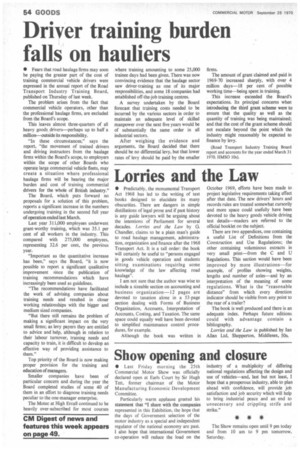Driver training burden falls on hauliers
Page 56

If you've noticed an error in this article please click here to report it so we can fix it.
• Fears that road haulage firms may soon be paying the greater part of the cost of training commercial vehicle drivers were expressed in the annual report of the Road Transport Industry Training Board, published on Thursday of last week.
The problem arises from the fact that commercial vehicle operators, other than the professional haulage firms, are excluded from the Board's scope.
This leaves almost three-quarters of all heavy goods_ drivers—perhaps up to half a million—outside its responsibility.
"In these circumstances.," says the report, "the movement of trained drivers and driving instructors from the haulage firms within the Board's scope, to employers within the scope of other Boards who operate large commercial vehicle fleets, may create a situation where professional haulage firms will be bearing the major burden and cost of training commercial drivers for the whole of British industry."
The Board, which puts forward no proposals for a solution of this problem, reports a significant increase in the numbers undergoing training in the second full year of operation ended last March.
Last year 311,000 employees underwent grant-worthy training, which was 35.1 per cent of all workers in the industry. This compared with 275,000 employees, representing 32.6 per cent, the previous year.
"Important as the quantitative increase has been," says the Board, "it is now possible to report a significant qualitative improvement since the publication of training recommendations which have increasingly been used as guidelines.
"The recommendations have facilitated the work of advising companies about training needs and resulted in closer working relationships with the bigger and medium sized companies.
"But there still remains the problem of making a significant impact on the very small firms; as levy payers they are entitled to advice and help, although in relation to their labour turnover, training needs and capacity to train, it is difficult to develop an effective way of providing assistance to them.
Top priority of the Board is now making proper provision for the training and education of managers.
Smaller companies have been of particular concern and during the year the Board completed studies of some 40 of them in an effort to diagnose training needs peculiar to the one-manager enterprise.
The Motec at High Ercall continued to be heavily over-subscribed for most courses ,where training amounting to some 25,000 trainee days had been given. There was now convincing evidence that the haulage sector saw driver-training as one of its major responsibilities, and some 18 companies had established off-the-job training centres.
A survey undertaken by the Board forecast that training costs needed to be incurred by the various sectors in order to maintain an adequate level of skilled manpower over the next five years would be of substantially the same order in all industrial sectors.
After weighing the evidence and arguments, the Board decided that there should be no differential levy, but that lower rates of levy should be paid by the smaller firms.
The amount of grant claimed and paid in 1969-70 increased sharply, with over 4 million days-18 per cent of possible working time—being spent in training.
This increase exceeded the Board's expectations, Its principal concerns when introducing the third grant scheme were to ensure that the quality as well as the quantity of training was being maintained; and that the cost of the grant scheme should not escalate beyond the point which the industry might reasonably be expected to finance by levy.
(Road Transport Industry Training Board report and accounts for the year ended March 31 1970. HMSO 10s).


























































































































































































